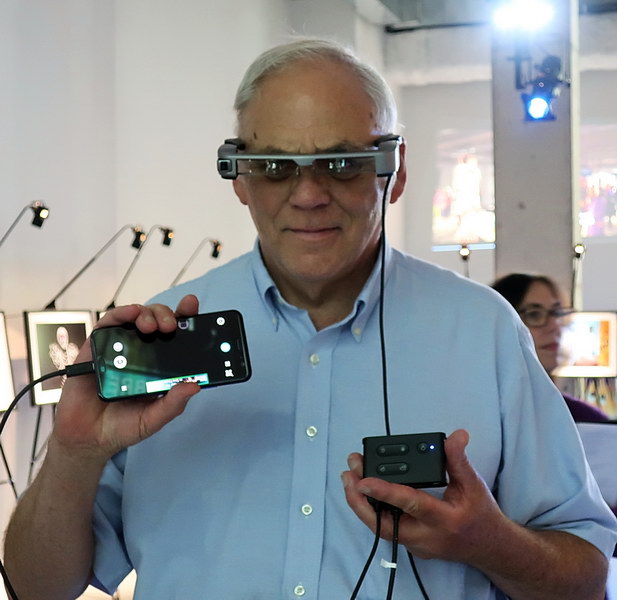On August 8th, Epson announced the latest version of their augmented reality (AR) Moverio product line, the Moverio BT-35E. Previous versions of the Moverio head mounted display (HMD) were intended to be driven by a dedicated Android controller from Epson but the BT-35E has been designed for use with existing hardware devices such as Android smartphones and tablets or Windows computers. The BT-35E includes a small interface box with HDMI and USB Type-C port.
 Epson Moverio BT-35E AR HMD system. Top and side view of the interface unit are on the left and the Moverio HMD is on the right. (Credit: Epson)
Epson Moverio BT-35E AR HMD system. Top and side view of the interface unit are on the left and the Moverio HMD is on the right. (Credit: Epson)
“Prior to the new Moverio BT-35E Smart Glasses, Moverio products have been standalone, and have included an Android based controller unit,” said Leon Laroue, technical product manager, augmented reality solutions, Epson. “Developed from customer insights, the Moverio BT-35E Smart Glasses represents Epson’s first smart glasses that provide users with wider access to content that they want on a wearable display through existing output devices.”
The Moverio BT-35E functions as a wearable display for any standard HDMI 1.4 output device, as well as any USB Type-C output device supporting DisplayPort Alt Mode. The system is HDCP 1.4 compliant for showing copy-protected content. When the host is connected via USB Type-C cable, the BT-35E can be powered by the host over the USB cable, otherwise a separate power pack is needed. This use of standard interfaces eliminates the need for Epson customers to create or port their existing applications to the Moverio platform.
 Meko’s Matt Brennesholtz tries the Epson Moverio BT-35E. He is holding the Android smartphone supplying the video in his right hand and the BT-35E interface box in his left hand. (Credit: M. Brennesholtz)
Meko’s Matt Brennesholtz tries the Epson Moverio BT-35E. He is holding the Android smartphone supplying the video in his right hand and the BT-35E interface box in his left hand. (Credit: M. Brennesholtz)
On the day they introduced the Moverio BT-35E, I had a chance to try one at an Epson event in New York. I was told by the Epson representative that the Moverio HMD itself is unchanged from the previous Moverio versions. It uses the same Epson-made OLED on Silicon (SiOLED, in Epson terms) 30fps, 720p (1280 x 720) microdisplay as the image source and the same prism-based optical combiner for the see-through virtual image and the direct view of the outside world. Because of the high inherent contrast of OLED microdisplays compared to LCD microdisplays, the Moverio imaging system produces less halo around the displayed information, which is especially important when the system is used at night. Since there are actually two microdisplays and two prism combiners in the Moverio HMD, the system can show stereoscopic 3D content.
The Moverio BT-35E I tried was connected to a smartphone via a USB-C connection and the smartphone was powering the Moverio HMD – no external power supply used on either the Moverio or the smartphone. The system worked fine and the image was great, but I can imagine this would drain the smartphone battery even faster than normal.
In the relatively dim surroundings of the Epson event space, the virtual image was almost too bright, but it could be easily dimmed by buttons on the control box. The Epson rep said that, to date, the biggest market for the Moverio has been for drone control. For this outdoor application, the bright image is very important. Going forward, Epson wants to capture additional markets such as industrial maintenance applications, etc. They have received many requests from potential customers who liked the Moverio HMD but did not want to port their application to a new Android device, i.e. the Epson Android Moverio controller. The BT-35E system is in response to these requests and will allow these customers to use their existing Android and Windows host systems.
The Moverio BT-35E Smart Glasses are available now for $899 through authorized Epson resellers and Epson.com. –Matthew Brennesholtz

